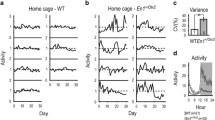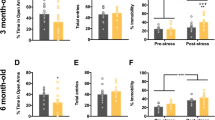Abstract
Bipolar disorder (BPD) is a genetically complex mental disorder, which is characterized by recurrent depressive and manic episodes, occurring with a typical cyclical course. In a recent study, we were able to identify a risk haplotype for BPD, as well as for unipolar depression and adult attention-deficit/hyperactivity disorder (ADHD), within the DGKH gene. DGKH codes for the eta (η) isoform of diacylglycerol kinase, which is involved in the phosphoinositol pathway. In the present study, we determined the expressional profile of Dgkh using quantitative real-time PCR (qPCR), in situ hybridization and immunohistological staining in the human and in the mouse brain. Expression studies showed that two different Dgkh transcripts exhibited distinct occurrence in a variety of murine tissues and also differed in their expression levels. The proteins encoded by those transcripts differ in functional protein domains suggesting distinct biochemical and cell biological properties and functions. qPCR analyses revealed an increase in Dgkh expression during mouse brain development indicating a possible role of this kinase in late developmental stages. Immunostainings revealed strong Dgkh expression in neurons of the hippocampus and the cerebellum of the murine brain, whereas highest expression levels of DGKH in the human brain were found in the striatum. Taken together, our studies revealed expressional changes during mouse brain development and occurrence of Dgkη in neurons of regions that have been linked to BPD as well as ADHD in humans providing evidence for the implication of DGKH in those disorders.







Similar content being viewed by others
References
Topham MK, Epand RM (2009) Mammalian diacylglycerol kinases: molecular interactions and biological functions of selected isoforms. Biochim Biophys Acta 1790(6):416–424. doi:10.1016/j.bbagen.2009.01.010
Sakane F, Imai S, Kai M, Yasuda S, Kanoh H (2007) Diacylglycerol kinases: why so many of them? Biochim et Biophys Acta Mol Cell Biol Lipids 1771(7):793–806
Topham MK (2006) Signaling roles of diacylglycerol kinases. J Cell Biochem 97(3):474–484. doi:10.1002/jcb.20704
Merida I, Avila-Flores A, Merino E (2008) Diacylglycerol kinases: at the hub of cell signalling. Biochem J 409:1–18
Murakami T, Sakane F, Imai S, Houkin K, Kanoh H (2003) Identification and characterization of two splice variants of human diacylglycerol kinase η. J Biol Chem 278(36):34364
Yasuda S, Kai M, Imai S, Takeishi K, Taketomi A, Toyota M, Kanoh H, Sakane F (2009) Diacylglycerol kinase eta augments C-Raf activity and B-Raf/C-Raf heterodimerization. J Biol Chem 284(43):29559–29570. doi:10.1074/jbc.M109.043604
Kolch W (2000) Meaningful relationships: the regulation of the Ras/Raf/MEK/ERK pathway by protein interactions. Biochem J 351(Pt 2):289
Badner JA, Gershon ES (2002) Meta-analysis of whole-genome linkage scans of bipolar disorder and schizophrenia. Mol Psychiatry 7(4):405–411. doi:10.1038/sj.mp.4001012
Segurado R, Detera-Wadleigh SD, Levinson DF, Lewis CM, Gill M, Nurnberger JI Jr, Craddock N, DePaulo JR, Baron M, Gershon ES, Ekholm J, Cichon S, Turecki G, Claes S, Kelsoe JR, Schofield PR, Badenhop RF, Morissette J, Coon H, Blackwood D, McInnes LA, Foroud T, Edenberg HJ, Reich T, Rice JP, Goate A, McInnis MG, McMahon FJ, Badner JA, Goldin LR, Bennett P, Willour VL, Zandi PP, Liu J, Gilliam C, Juo SH, Berrettini WH, Yoshikawa T, Peltonen L, Lonnqvist J, Nothen MM, Schumacher J, Windemuth C, Rietschel M, Propping P, Maier W, Alda M, Grof P, Rouleau GA, Del-Favero J, Van Broeckhoven C, Mendlewicz J, Adolfsson R, Spence MA, Luebbert H, Adams LJ, Donald JA, Mitchell PB, Barden N, Shink E, Byerley W, Muir W, Visscher PM, Macgregor S, Gurling H, Kalsi G, McQuillin A, Escamilla MA, Reus VI, Leon P, Freimer NB, Ewald H, Kruse TA, Mors O, Radhakrishna U, Blouin JL, Antonarakis SE, Akarsu N (2003) Genome scan meta-analysis of schizophrenia and bipolar disorder, part III: bipolar disorder. Am J Hum Genet 73(1):49–62. doi:10.1086/376547
Merikangas KR, Akiskal HS, Angst J, Greenberg PE, Hirschfeld RM, Petukhova M, Kessler RC (2007) Lifetime and 12-month prevalence of bipolar spectrum disorder in the National Comorbidity Survey replication. Arch Gen Psychiatry 64(5):543–552. doi:10.1001/archpsyc.64.5.543
Bauer M, Pfennig A (2005) Epidemiology of bipolar disorders. Epilepsia 46(Suppl 4):8–13
Kessler RC, Akiskal HS, Ames M, Birnbaum H, Greenberg P, Hirschfeld RM, Jin R, Merikangas KR, Simon GE, Wang PS (2006) Prevalence and effects of mood disorders on work performance in a nationally representative sample of US workers. Am J Psychiatry 163(9):1561–1568. doi:10.1176/appi.ajp.163.9.1561
Kendler KS, Pedersen NL, Neale MC, Mathe AA (1995) A pilot Swedish twin study of affective illness including hospital- and population-ascertained subsamples: results of model fitting. Behav Genet 25(3):217–232
McGuffin P, Rijsdijk F, Andrew M, Sham P, Katz R, Cardno A (2003) The heritability of bipolar affective disorder and the genetic relationship to unipolar depression. Arch Gen Psychiatry 60(5):497–502. doi:10.1001/archpsyc.60.5.497
Kieseppa T, Partonen T, Haukka J, Kaprio J, Lonnqvist J (2004) High concordance of bipolar I disorder in a nationwide sample of twins. Am J Psychiatry 161(10):1814–1821. doi:10.1176/appi.ajp.161.10.1814
Baum AE, Akula N, Cabanero M, Cardona I, Corona W, Klemens B, Schulze TG, Cichon S, Rietschel M, Nothen MM, Georgi A, Schumacher J, Schwarz M, Abou Jamra R, Hofels S, Propping P, Satagopan J, Detera-Wadleigh SD, Hardy J, McMahon FJ (2008) A genome-wide association study implicates diacylglycerol kinase eta (DGKH) and several other genes in the etiology of bipolar disorder. Mol Psychiatry 13(2):197–207. doi:10.1038/sj.mp.4002012
Ollila HM, Soronen P, Silander K, Palo OM, Kieseppa T, Kaunisto MA, Lonnqvist J, Peltonen L, Partonen T, Paunio T (2009) Findings from bipolar disorder genome-wide association studies replicate in a Finnish bipolar family-cohort. Mol Psychiatry 14(4):351–353. doi:10.1038/mp.2008.122
Squassina A, Manchia M, Congiu D, Severino G, Chillotti C, Ardau R, Piccardi M, Zompo MD (2009) The diacylglycerol kinase eta gene and bipolar disorder: a replication study in a Sardinian sample. Mol Psychiatry 14(4):350–351. doi:10.1038/mp.2008.93
Zeng Z, Wang T, Li T, Li Y, Chen P, Zhao Q, Liu J, Li J, Feng G, He L, Shi Y (2011) Common SNPs and haplotypes in DGKH are associated with bipolar disorder and schizophrenia in the Chinese Han population. Mol Psychiatry 16(5):473–475. doi:10.1038/mp.2010.86
Weber H, Kittel-Schneider S, Gessner A, Domschke K, Neuner M, Jacob CP, Buttenschon HN, Boreatti-Hümmer A, Volkert J, Herterich S (2011) Cross-disorder analysis of bipolar risk genes: further evidence of DGKH as a risk gene for bipolar disorder, but also unipolar depression and adult ADHD. Neuropsychopharmacology 36(10):2076–2085
Kittel-Schneider S, Wobrock T, Scherk H, Schneider-Axmann T, Trost S, Zilles D, Wolf C, Schmitt A, Malchow B, Hasan A, Backens M, Reith W, Falkai P, Gruber O, Reif A (2015) Influence of DGKH variants on amygdala volume in patients with bipolar affective disorder and schizophrenia. Eur Arch Psychiatry Clin Neurosci 265(2):127–136. doi:10.1007/s00406-014-0513-9
Moya PR, Murphy DL, McMahon FJ, Wendland JR (2010) Increased gene expression of diacylglycerol kinase eta in bipolar disorder. Int J Neuropsychopharmacol 13(8):1127–1128. doi:10.1017/S1461145710000593
Whalley HC, Papmeyer M, Romaniuk L, Johnstone EC, Hall J, Lawrie SM, Sussmann JE, McIntosh AM (2011) Effect of variation in diacylglycerol kinase eta (DGKH) gene on brain function in a cohort at familial risk of bipolar disorder. Neuropsychopharmacology. doi:10.1038/npp.2011.272
Manji HK, Lenox RH (1999) Ziskind-Somerfeld research award. Protein kinase C signaling in the brain: molecular transduction of mood stabilization in the treatment of manic-depressive illness. Biol Psychiatry 46(10):1328–1351
Ramakers C, Ruijter JM, Deprez RH, Moorman AF (2003) Assumption-free analysis of quantitative real-time polymerase chain reaction (PCR) data. Neurosci Lett 339(1):62–66
Vandesompele J, De Preter K, Pattyn F, Poppe B, Van Roy N, De Paepe A, Speleman F (2002) Accurate normalization of real-time quantitative RT-PCR data by geometric averaging of multiple internal control genes. Genome Biol 3 (7):RESEARCH0034
Palop JJ, Roberson ED, Cobos I (2011) Step-by-step in situ hybridization method for localizing gene expression changes in the brain. Methods Mol Biol 670:207–230. doi:10.1007/978-1-60761-744-0_15
Shionoya T, Usuki T, Komenoi S, Isozaki T, Sakai H, Sakane F (2015) Distinct expression and localization of the type II diacylglycerol kinase isozymes delta, eta and kappa in the mouse reproductive organs. BMC Dev Biol 15:6. doi:10.1186/s12861-015-0055-z
Drevets WC, Price JL, Simpson JR Jr, Todd RD, Reich T, Vannier M, Raichle ME (1997) Subgenual prefrontal cortex abnormalities in mood disorders. Nature 386(6627):824–827. doi:10.1038/386824a0
Barkley RA (1997) Behavioral inhibition, sustained attention, and executive functions: constructing a unifying theory of ADHD. Psychol Bull 121(1):65–94
Finlay BL, Darlington RB (1995) Linked regularities in the development and evolution of mammalian brains. Science 268(5217):1578–1584
Cubillo A, Halari R, Smith A, Taylor E, Rubia K (2012) A review of fronto-striatal and fronto-cortical brain abnormalities in children and adults with attention deficit hyperactivity disorder (ADHD) and new evidence for dysfunction in adults with ADHD during motivation and attention. Cortex 48(2):194–215. doi:10.1016/j.cortex.2011.04.007
Aylward EH, Roberts-Twillie JV, Barta PE, Kumar AJ, Harris GJ, Geer M, Peyser CE, Pearlson GD (1994) Basal ganglia volumes and white matter hyperintensities in patients with bipolar disorder. Am J Psychiatry 151(5):687–693
Strakowski SM, DelBello MP, Zimmerman ME, Getz GE, Mills NP, Ret J, Shear P, Adler CM (2002) Ventricular and periventricular structural volumes in first- versus multiple-episode bipolar disorder. Am J Psychiatry 159(11):1841–1847
Noga JT, Vladar K, Torrey EF (2001) A volumetric magnetic resonance imaging study of monozygotic twins discordant for bipolar disorder. Psychiatry Res 106(1):25–34
DelBello MP, Zimmerman ME, Mills NP, Getz GE, Strakowski SM (2004) Magnetic resonance imaging analysis of amygdala and other subcortical brain regions in adolescents with bipolar disorder. Bipolar Disord 6(1):43–52
Swayze VW, Andreasen NC, Alliger RJ, Yuh WTC, Ehrhardt JC (1992) Subcortical and temporal structures in affective disorder and schizophrenia: a magnetic resonance imaging study. Biol Psychiatry 31(3):221–240
Blumberg HP, Kaufman J, Martin A, Whiteman R, Zhang JH, Gore JC, Charney DS, Krystal JH, Peterson BS (2003) Amygdala and hippocampal volumes in adolescents and adults with bipolar disorder. Arch Gen Psychiatry 60(12):1201
Kim K, Yang J, Zhong XP, Kim MH, Kim YS, Lee HW, Han S, Choi J, Han K, Seo J (2009) Synaptic removal of diacylglycerol by DGKζ and PSD-95 regulates dendritic spine maintenance. EMBO J 28(8):1170–1179
Baldaçara L, Borgio JGF, Lacerda ALT, Jackowski AP (2008) Cerebellum and psychiatric disorders. Rev Bras de Psiquiatr 30(3):281–289
Konrad K, Eickhoff SB (2010) Is the ADHD brain wired differently? A review on structural and functional connectivity in attention deficit hyperactivity disorder. Hum Brain Mapp 31(6):904–916. doi:10.1002/hbm.21058
Baldaçara L, Nery-Fernandes F, Rocha M, Quarantini L, Rocha G, Guimarães J, Araújo C, Oliveira I, Miranda-Scippa A, Jackowski A (2011) Is cerebellar volume related to bipolar disorder? J Affect Disord 135(1–3):305–309
Acknowledgments
We thank Dr. Claudia Kriegebaum for providing the RNA of different murine tissues and Marion Winnig for expert technical assistance.
Author information
Authors and Affiliations
Corresponding author
Ethics declarations
Conflict of interest
The authors declare that they have no conflict of interest.
Ethical standards
The manuscript does not contain clinical studies or patient data.
Rights and permissions
About this article
Cite this article
Weißflog, L., Becker, N., Bossert, N. et al. Expressional profile of the diacylglycerol kinase eta gene DGKH . Eur Arch Psychiatry Clin Neurosci 267, 445–454 (2017). https://doi.org/10.1007/s00406-016-0695-4
Received:
Accepted:
Published:
Issue Date:
DOI: https://doi.org/10.1007/s00406-016-0695-4




